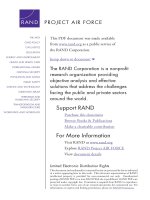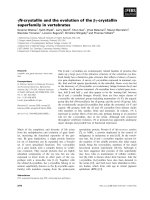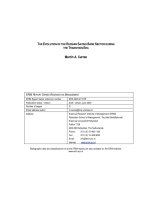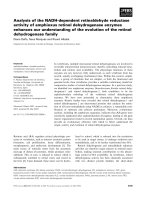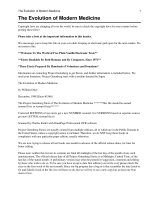The evolution of populations
Bạn đang xem bản rút gọn của tài liệu. Xem và tải ngay bản đầy đủ của tài liệu tại đây (1.4 MB, 61 trang )
Chapter 23
The Evolution of Populations
PowerPoint Lectures for
Biology, Seventh Edition
Neil Campbell and Jane Reece
Lectures by Chris Romero
Copyright © 2005 Pearson Education, Inc. publishing as Benjamin Cummings
• Overview: The Smallest Unit of Evolution
• One common misconception about evolution is
that individual organisms evolve, in the
Darwinian sense, during their lifetimes
• Natural selection acts on individuals, but
populations evolve
Copyright © 2005 Pearson Education, Inc. publishing as Benjamin Cummings
• Genetic variations in populations
– Contribute to evolution
Figure 23.1
Copyright © 2005 Pearson Education, Inc. publishing as Benjamin Cummings
• Concept 23.1: Population genetics provides a
foundation for studying evolution
• Microevolution
– Is change in the genetic makeup of a
population from generation to generation
Figure 23.2
Copyright © 2005 Pearson Education, Inc. publishing as Benjamin Cummings
The Modern Synthesis
• Population genetics
– Is the study of how populations change
genetically over time
– Reconciled Darwin’s and Mendel’s ideas
Copyright © 2005 Pearson Education, Inc. publishing as Benjamin Cummings
• The modern synthesis
– Integrates Mendelian genetics with the
Darwinian theory of evolution by natural
selection
– Focuses on populations as units of evolution
Copyright © 2005 Pearson Education, Inc. publishing as Benjamin Cummings
Gene Pools and Allele Frequencies
• A population
MAP
AREA
CANADA
ALASKA
– Is a localized group of individuals that are capable of
interbreeding and producing fertile offspring
Beaufort Sea
Porcupine
herd range
N
TE OR
RR TH
IT WE
O S
RI T
ES
Fortymile
herd range
ALASKA
YUKON
•
Fairbanks
•
Whitehorse
Figure 23.3
Copyright © 2005 Pearson Education, Inc. publishing as Benjamin Cummings
• The gene pool
– Is the total aggregate of genes in a population
at any one time
– Consists of all gene loci in all individuals of the
population
Copyright © 2005 Pearson Education, Inc. publishing as Benjamin Cummings
The Hardy-Weinberg Theorem
• The Hardy-Weinberg theorem
– Describes a population that is not evolving
– States that the frequencies of alleles and
genotypes in a population’s gene pool remain
constant from generation to generation
provided that only Mendelian segregation and
recombination of alleles are at work
Copyright © 2005 Pearson Education, Inc. publishing as Benjamin Cummings
• Mendelian inheritance
– Preserves genetic variation in a population
Generation
1
CWCW
CRCR
genotype
genotype
Plants mate
Generation
2
All CRCW
(all pink flowers)
50% CR
gametes
50% CW
gametes
Come together at random
Generation
3
25% CRCR
50% CRCW
50% CR
gametes
25% CWCW
50% CW
gametes
Come together at random
Generation
4
25% CRCR
Figure 23.4
Copyright © 2005 Pearson Education, Inc. publishing as Benjamin Cummings
50% CRCW
25% CWCW
Alleles segregate, and subsequent
generations also have three types
of flowers in the same proportions
Preservation of Allele Frequencies
• In a given population where gametes
contribute to the next generation randomly,
allele frequencies will not change
Copyright © 2005 Pearson Education, Inc. publishing as Benjamin Cummings
Hardy-Weinberg Equilibrium
• Hardy-Weinberg equilibrium
– Describes a population in which random
mating occurs
– Describes a population where allele
frequencies do not change
Copyright © 2005 Pearson Education, Inc. publishing as Benjamin Cummings
• A population in Hardy-Weinberg equilibrium
Gametes for each generation are drawn at random from
the gene pool of the previous generation:
80% CR (p = 0.8)
20% CW (q = 0.2)
Sperm
CR
(80%)
CW
(20%)
pq
CR
(80%)
p2
64%
CRCR
CW
(20%)
Eggs
p2
16%
CRCW
16%
CRCW
qp
4%
CWCW
q2
If the gametes come together at random, the genotype
frequencies of this generation are in Hardy-Weinberg equilibrium:
64% CRCR, 32% CRCW, and 4% CWCW
Gametes of the next generation:
16% CR from
64% CR from
+
CRCW homozygotes
CRCR homozygotes
4% CW from
CWCW homozygotes
+
16% CW from
CRCW heterozygotes
=
80% CR = 0.8 = p
=
20% CW = 0.2 = q
With random mating, these gametes will result in the same
mix of plants in the next generation:
Figure 23.5
64% CRCR, 32% CRCW and 4% CWCW plants
Copyright © 2005 Pearson Education, Inc. publishing as Benjamin Cummings
• If p and q represent the relative frequencies of
the only two possible alleles in a population at
a particular locus, then
– p2 + 2pq + q2 = 1
– And p2 and q2 represent the frequencies of the
homozygous genotypes and 2pq represents
the frequency of the heterozygous genotype
Copyright © 2005 Pearson Education, Inc. publishing as Benjamin Cummings
Conditions for Hardy-Weinberg Equilibrium
• The Hardy-Weinberg theorem
– Describes a hypothetical population
• In real populations
– Allele and genotype frequencies do change
over time
Copyright © 2005 Pearson Education, Inc. publishing as Benjamin Cummings
• The five conditions for non-evolving
populations are rarely met in nature
– Extremely large population size
– No gene flow
– No mutations
– Random mating
– No natural selection
Copyright © 2005 Pearson Education, Inc. publishing as Benjamin Cummings
Population Genetics and Human Health
• We can use the Hardy-Weinberg equation
– To estimate the percentage of the human
population carrying the allele for an inherited
disease
Copyright © 2005 Pearson Education, Inc. publishing as Benjamin Cummings
• Concept 23.2: Mutation and sexual
recombination produce the variation that
makes evolution possible
• Two processes, mutation and sexual
recombination
– Produce the variation in gene pools that
contributes to differences among individuals
Copyright © 2005 Pearson Education, Inc. publishing as Benjamin Cummings
Mutation
• Mutations
– Are changes in the nucleotide sequence of DNA
– Cause new genes and alleles to arise
Figure 23.6
Copyright © 2005 Pearson Education, Inc. publishing as Benjamin Cummings
Point Mutations
• A point mutation
– Is a change in one base in a gene
– Can have a significant impact on phenotype
– Is usually harmless, but may have an adaptive
impact
Copyright © 2005 Pearson Education, Inc. publishing as Benjamin Cummings
Mutations That Alter Gene Number or Sequence
• Chromosomal mutations that affect many loci
– Are almost certain to be harmful
– May be neutral and even beneficial
Copyright © 2005 Pearson Education, Inc. publishing as Benjamin Cummings
• Gene duplication
– Duplicates chromosome segments
Copyright © 2005 Pearson Education, Inc. publishing as Benjamin Cummings
Mutation Rates
• Mutation rates
– Tend to be low in animals and plants
– Average about one mutation in every 100,000
genes per generation
– Are more rapid in microorganisms
Copyright © 2005 Pearson Education, Inc. publishing as Benjamin Cummings
Sexual Recombination
• In sexually reproducing populations, sexual
recombination
– Is far more important than mutation in
producing the genetic differences that make
adaptation possible
Copyright © 2005 Pearson Education, Inc. publishing as Benjamin Cummings
• Concept 23.3: Natural selection, genetic drift,
and gene flow can alter a population’s genetic
composition
• Three major factors alter allele frequencies and
bring about most evolutionary change
– Natural selection
– Genetic drift
– Gene flow
Copyright © 2005 Pearson Education, Inc. publishing as Benjamin Cummings

